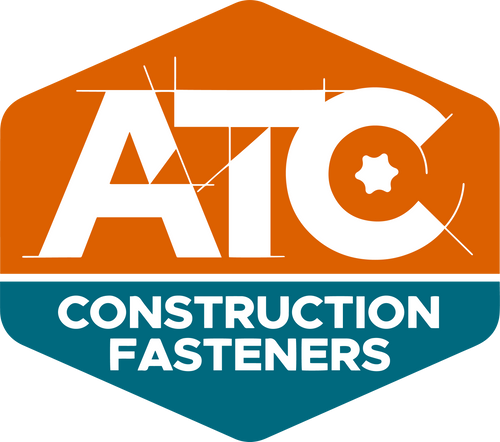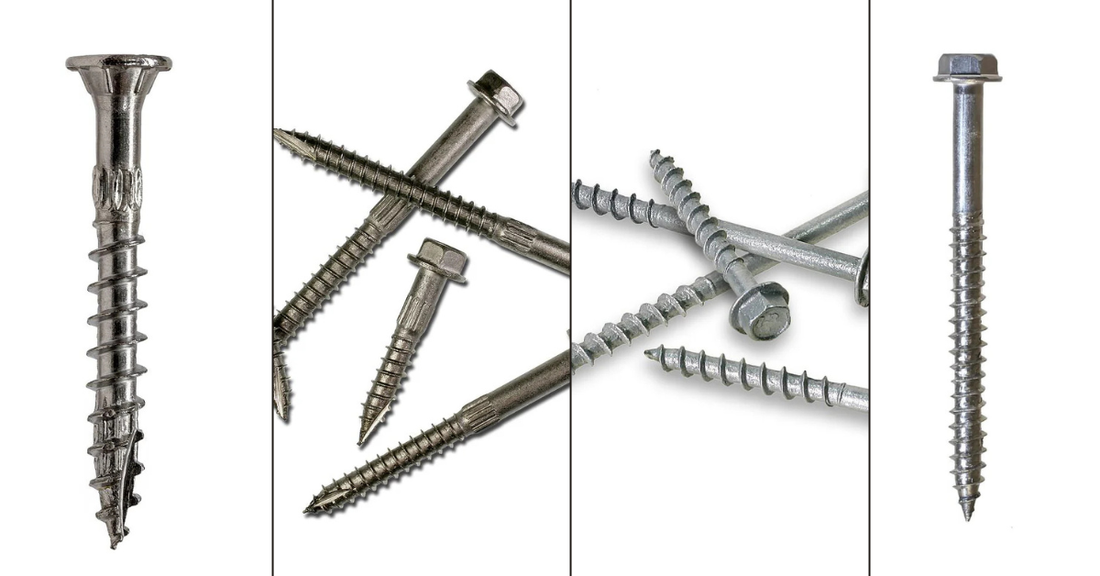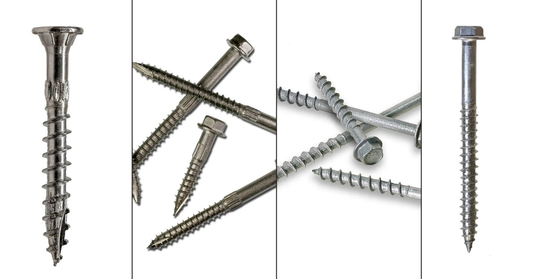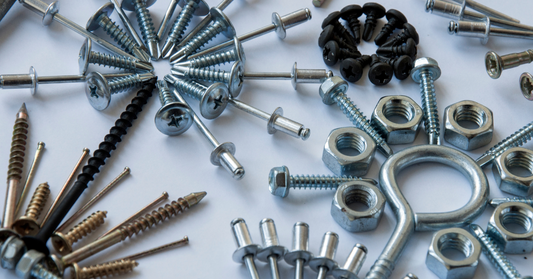We've been building wooden structures for almost 30 years, and most of our builds are still structurally sound today. The difference between decks lasting three decades and ones collapsing after ten? Often just the fasteners. Not the wood you picked, not some fancy design, the screws!
You need the best screws for structural timber. Standard construction screws won't cut it for load-bearing stuff. Deck screws? Nope. Just because it says "heavy duty" on the box it doesn't mean its for structural components.
Everything here pulls from our projects, inspector feedback, and Simpson Strong-Tie technical docs. Only what actually works for code compliance and long-term durability.
TL;DR (What Are The Best Structural Wood Screws?)
- Best deck ledger screws: Simpson Strong-Drive SDWS timber (316 SS for coastal decks) screws or SDWH hex screws are the best for code-compliant ledger connections.
- Best structural screws for deck joists: Simpson Strong-Tie SDS Heavy Duty Connector Screws are the best for joist hanger installations.
- Best screws for docks and marine structures: Simpson Strong-Drive SDWS 316 stainless steel screws are the best for saltwater resistance.
- Best screws for pergolas: Simpson Strong-Drive SDWH Timber-Hex 316 stainless steel screws are the best for large timber connections.
- Best screws for retaining walls: Simpson Strong-Drive SDWS heavy gauge screws are the best for soil pressure resistance.
- Best screws for LVL beams: Simpson Strong-Tie SDS screws in 1/4" diameter are the best for engineered lumber.
What Makes a Screw Structural?
Verified load ratings, ICC-ES code approval, and specific shear and withdrawal strength values make a screw structural. Standard wood screws lack independent testing, published design values, and required certifications.
You can't just eyeball a screw to know if it's structural. Length or thickness doesn't mean structural. The difference comes down to testing, documentation, and whether engineers accept it.
Deck Ledgers and Joist Hangers
Ledger failures kill people. When decks collapse, it's almost always because the ledger pulled away from the house. IRC R507.8 and IBC 1604.8.3 both require positive anchorage for vertical and lateral loads. Every inspector scrutinizes this connection before anything else.

Simpson Strong-Drive SDWS and SDWH deck ledger screws carry IAPMO UES ER-192 approval and show up in IRC Table R507.9.1.3. These structural screws for deck ledger connections have replaced traditional deck ledger bolts on most projects.
Why Simpson Strong-Drive SDWS and SDWH Ledger Screws Are The Best For Deck Ledgers:
- Skip predrilling (deck ledger bolts need pilot holes)
- IRC-listed with verified load ratings
- Type 316 stainless available for coastal jobs
- Adjust locations on the fly if you hit a knot
Choose Simpson SDWS if you prefer Torx drive (T40 or T50) and need .220" or .275" diameter. Choose SDWH if you want hex drive (5/16" or 1/2") with washer head for drainage gaps.
Buy SDWS Screws →
Buy SDWH Screws →
Why Simpson Strong-Tie SDS Heavy Duty Connector Screws Are The Best For Deck Joist Hangers:
- Required structural joist screws for all Simpson metal connectors
- Thread geometry matches punched hole tolerances
- Load-rated specifically for Simpson connectors
- Hex head provides maximum torque transfer
Wrong screws for joist hangers deck installations significantly weaken connector strength. Each connector specifies exact screw requirements, and swapping in random deck screws on joist hangers creates dangerous connections. Using Simpson SDWS where you need SDS gets you a red tag.
Docks and Marine Environments
Saltwater eats through regular fasteners in under a year. Dock collapses from corroded screws happen more than anyone wants to admit, and insurance companies don't care if you "didn't know" you needed marine-grade hardware.
Simpson Strong-Drive SDWS Structural Stainless Steel Screws (316 Grade) and Strong-Drive SDS Heavy Duty Hex Connector Screws (316 Grade) survive what regular screws can't. Wave action, constant moisture, and chloride exposure combine to destroy standard fasteners, but 316 stainless holds up decade after decade.
Why Simpson Strong-Drive SDWS 316 Stainless Steel Screws Are The Best For Dock Construction:
- Type 316 resists chloride pitting (304 stainless rusts out in salt spray)
- Washer head spreads loads across pressure-treated marine lumber
- No predrilling in hardwoods like Ipe or treated Southern Pine
- SawTooth threading maintains grip in wet timber cycles
Choose Simpson Strong-Drive SDWS screws for decking planks, structural screws for rim joist, and wood-to-wood connections where you're not using metal hangers. Pick Simpson Strong-Tie SDS Heavy Duty Connector Screws when replacing through-bolts on beam-to-post or blocking connections.
Freshwater docks sometimes get away with HCR coatings, but anything near oceans, bays, or brackish water needs real 316 stainless. Coastal building codes often mandate marine-grade fasteners by law, not preference.
Pergolas and Outdoor Structures
Pergola beams spanning 12 feet without center support put serious stress on every fastener holding that structure together. Snow loads, wind shear, and decades of weather separate good screws from garbage ones fast.
Simpson Strong-Drive SDWH Timber-Hex Stainless Steel Screws (316 Grade) combine code-rated strength with finished appearance. The stainless steel construction handles outdoor exposure while the hex drive delivers the torque needed for large timber connections.
Why Simpson Strong-Drive SDWH Timber-Hex 316 Screws Are The Best For Pergola Builds:
- 316 stainless steel resists decades of weather exposure
- Installs without pilot holes (saves hours on multi-beam assemblies)
- Load tables cover beam-to-post shear connections
- Works in rough-sawn local timber or dimensional lumber
Post-to-beam joints carry massive shear forces that deck screws can't handle. Simpson Strong-Tie SDS screws in 1/4" diameter take these loads where smaller fasteners shear clean off. The hex washer head distributes clamping pressure across the connection instead of crushing wood fibers like undersized hardware does.
Lag screws used to be standard, but they require exact pilot holes and split timber near edges. Simpson Strong-Tie wood screws go in faster, hold better, and don't crack your expensive lumber.
Retaining Walls and Landscape Timber
Stacked timber walls hold back literal tons of soil pressure. Regular wood screws pull out under that constant lateral load, and when retaining walls fail, they fail catastrophically.
Simpson Strong-Drive SDWS screws in heavy gauge lock courses together against soil pressure. For 4x4 or 6x6 timber walls, you need 5/16" diameter minimum with washer heads that resist pull-through.
Why Simpson Strong-Drive SDWS Structural Stainless Steel Screws Are The Best For Retaining Walls:
- Lateral soil loading demands fasteners rated for shear and withdrawal
- Treated lumber splits without self-drilling points
- Constant moisture behind walls requires corrosion-resistant coatings
- Code-listed load values simplify engineering approval
Post-and-panel walls (vertical 4x4 posts with horizontal 2x boards) need Simpson Strong-Drive SDWS screws in #10 or #14 gauge. The thread pattern pulls panels tight while resisting backfill pressure that would yank nails straight out.
Installation reality check: Even perfect structural screws won't save walls without gravel backfill and drainage pipe. Water pressure will tear apart any wall, regardless of fastener quality. Step each course back 1/4 inch and add deadman anchors on anything over 3 feet tall.
Walls exceeding local height limits (usually 3-4 feet) trigger structural engineering requirements. Using Simpson structural screws with published load tables gets you through permitting faster than explaining why you grabbed random fasteners at the hardware store.
Multi-Ply Beam Connections
Laminating 2x10s or 2x12s into beams creates loads that regular screws can't handle. Each ply needs to act as one unit, and that demands fasteners designed specifically for multi-member assemblies.

Simpson SDS screws excel at multi-ply connections because the washer head clamps layers together without crushing wood. For LVL, LSL, or PSL beams (engineered lumber products), these Simpson LVL screws penetrate dense laminations without predrilling.
Why Simpson Strong-Drive SDS Heavy Duty Hex Connector Screws Are The Best For Multi-Ply Beam Assembly:
- Hex washer head distributes clamping loads across laminations
- Type-17 auger point eliminates predrilling in engineered lumber
- Thread design matches density of composite materials
- ICC-ES ESR-2236 listing covers LVL, LSL, PSL applications
Standard construction screws lack the head geometry and thread profile needed for multi-ply work. The thin heads crush into wood, and the threads strip out in engineered lumber's dense layers.
Spacing matters here: Simpson publishes exact patterns for stitch-fastening multiple plies. Random screw placement doesn't create composite action, it just pokes holes in expensive lumber.
Tips on How to Choose the Best Structural Wood Screws for Every Timber Construction Project

1. Match Load Type to Screw Design
Shear versus withdrawal loading changes everything about how your screws perform. For shear applications where forces push sideways, you want L = 8D (that's length equals eight times diameter in each member you're joining).
Withdrawal loading needs deeper penetration at L = 16D to resist pull-out forces. Getting this wrong means undersized connections that fail inspection or oversized fasteners that blow your budget on unnecessary material.
2. Pick the Right Length Using the Two-Thirds Rule
Thread two-thirds of your screw into the receiving member. This ensures solid bite without bottoming out or poking through the opposite side. For a 2x4 to a header, you're aiming for 1 to 1.5 inches minimum penetration into that header. Short screws pull out under load, while too much length splits wood or hits a hanger.
3. Select Diameter Based on Application Demands
The right gauge makes all the difference:
- #6: trim and light work
- #8: cabinets and furniture
- #10: heavy framing and beams
For big timber, use screws equal to 3/8" or 1/2" lags. Undersized screws on main framing and beams just don't cut it.
4. Account for Wood Species Characteristics
Species and condition matter for pull strength. Douglas Fir and Southern Pine have more holding power than soft spruce or hemlock, and dry lumber is much more likely to split. If you're in engineered wood like LVL or glulam, double-check that the screw specs actually cover it before getting started.
5. Choose Thread Type for Material Compatibility
Coarse threads work in softwoods, plywood, and OSB because the wider spacing lets wood fibers settle between each thread. This prevents stripping when you drive screws into pine or cedar.
Outdoor wood screws with fine threads are best for hardwoods and engineered lumber. The shallow pitch means more threads per inch grabbing the material, which keeps screws from backing out. Got a project with vibration (stairs, equipment mounts)? Fine threads resist loosening way better than coarse.
6. Prioritize Corrosion Protection
Coating choice depends on where you're building:
- Indoors? Standard zinc does the trick.
- Pressure-treated? Use ACQ-approved coatings so the lumber chemicals don't eat your screws.
- Near the coast? There's no substitute for 316 stainless steel.
Not using the right weatherproof structural wood screws is just signing up for a redo down the road.
7. Use Head Style to Control Connection Behavior
Washer heads give muscle for ledger or heavy beam connections, stopping pull-through. Go for countersunk when you want everything flush (like formwork or battens). Hex heads on thick screws take more torque, but go in faster with an impact gun.
8. Follow Code-Specified Spacing Requirements
You can't guess your way on spacing and edge distance.
- Minimum edge distance: 1-3/4 inches.
- End distance: 6 inches is the norm.
Screws aren't a one-to-one swap for bolts, so always check the manufacturer's spacing charts. When it comes to ledgers, W-pattern staggering helps spread the forces in real builds.
9. Verify Load Ratings Against Actual Demands
Lateral load ratings change based on wood type and whether you're going with or across the grain. Pull-out strength comes from thread engagement length, not just the sticker length. Always match what's required by code or plans to your screw's actual strength, including any adjustment factors for wet conditions or how long those loads might last.
10. Match Drive System to Installation Equipment
Star drives won't strip like a phillips under heavy torque. Keep your driver bits handy and in good shape so you're never slowed down working through a big box of Simpson screws
The Best Supplier Of The Best Screws For Structural Timber
Inspectors see dozens of brands claiming "structural grade." Most don't have ICC-ES reports. Simpson has over 20 years of testing data backing every claim.
Reddit threads debate GRK versus Simpson constantly. Both pass code. But when an engineer stamps plans specifying "structural wood screws per ER-192," you need Simpson. Using another brand means submitting new engineering or getting plan revisions.
Since 2008, ATC Construction Fasteners has supplied contractors with the best screws for structural timber that match project specs the first time. We carry the right fasteners with the right certifications.
Sign up as a contractor to access discounted prices, a tailored shopping experience, and additional benefits. Register today for 5% off everything!
Buy SDWS Screws →
Buy SDWH Screws →
FAQs
How to tell if a screw is structural?
To tell if a screw is structural, check the box for an ICC-ES report number like ER-192 or ESR-2236. Structural wood fasteners brands list published shear and withdrawal values in pounds. Regular wood screws don't include this documentation. Look for brands like Simpson Strong-Tie, GRK, or FastenMaster that provide technical evaluation reports.
Can I use Eagle Claw screws for structural deck components?
No, you can’t use Eagle Claw screws for structural connections. However, Eagle Claw deck screws are the best stainless steel deck screws. They have the same quality as Simpson Strong-Ties, but offer a better pricing for stainless steel wood screws.
We’ve built hundreds of decks using Eagle Claw SS screws to fasten decking boards and Simpson structural wood screws for ledgers and joists.
Are structural screws as strong as lag bolts?
Structural screws are stronger per diameter than lag bolts. They use hardened heat-treated steel that outperforms the soft steel in traditional lag bolts. A 1/4" structural screw matches or beats a 3/8" lag bolt for shear strength.
Structural screws require no predrilling, which means less wood damage and better holding power. Installation goes faster, and no wrench is needed. You can still use lag bolts, but if you want to get the job done faster, use screws.




